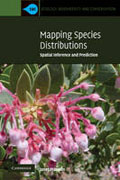
Maps of species' distributions or habitat suitability are required for many aspects of environmental research, resource management and conservation planning. These include biodiversity assessment, reserve design, habitat management and restoration, species and habitat conservation plans and predicting the effects of environmental change on species and ecosystems. The proliferation of methods and uncertainty regarding their effectiveness can be daunting to researchers, resource managers and conservation planners alike. Franklin summarises the methods used in species distribution modeling (also called niche modeling) and presents a framework for spatial prediction of species distributions basedon the attributes (space, time, scale) of the data and questions being asked.The framework links theoretical ecological models of species distributions tospatial data on species and environment, and statistical models used for spatial prediction. Providing practical guidelines to students, researchers and practitioners in a broad range of environmental sciences including ecology, geography, conservation biology, and natural resources management. INDICE: Part I. History and Ecological Basis of Species' Distribution Modeling: 1. Species distribution modeling; 2. Why do we need species' distribution models?; 3. Ecological understanding of species' distributions; Part II. TheData Needed for Modeling Species' Distributions; 4. Data for species' distribution models: the biological data; 5. Data for species' distribution models: the environmental data; Part III. An Overview of the Modeling Methods: 6. Statistical models - modern regression; 7. Machine learning methods; 8. Classification, similarity and other methods for presence-only data; Part IV. Model Evaluation and Implementation: 9. Model evaluation; 10. Implementation of species' distribution models.
- ISBN: 978-0-521-70002-3
- Editorial: Cambridge University Press
- Encuadernacion: Rústica
- Páginas: 338
- Fecha Publicación: 07/01/2010
- Nº Volúmenes: 1
- Idioma: Inglés
